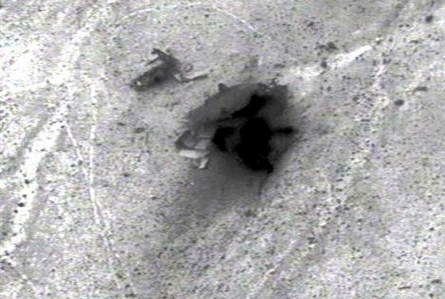A paperwork glitch has deprived investigators of the flight incident recorder on board a crashed Bell Boeing CV-22 tiltrotor despite evidence that the critical device survived, according to the president of a US Air Force accident investigation board.
The precise cause of the 9 April crash by a CV-22 attempting to land in wadi at roughly 5,000ft (1,520m) above sea level near Qalat, Afghanistan, remains a mystery because Air Force Special Operations Command (AFSOC) crews were unaware that the CV-22 is equipped with a device that records flight information, says the board's president Brig Gen Donald Harvel (Ret).
 |
|---|
© AFSOC |
AFSOC crews were never told that a flight incident recorder is on board all CV-22s, Harvel says. The instructional manuals for the CV-22s were inherited from the US Marine Corps MV-22B Osprey programme. The manuals needed to be translated from Marine jargon to air force terminology, but the translators made mistakes, Harvel says.
"Somehow in that translation there was nothing in [the AFSOC manual] that showed this aircraft had a [flight incident recorder]," he says. "They had absolutely no idea."
As a result, he adds, the recorder "was never on the list to get that off the airplane" after a crash.
Despite three trips to the crash site by rescue and salvage crews, the recorder was never recovered, fuelling a rare clash in public between safety investigators and AFSOC over opposing theories.
After recovering 16 survivors and four bodies, plus other sensitive equipment, from the crash site, the remains of the CV-22 were destroyed by a bomb, Harvel says. However, the flight incident recorder is designed to survive such an explosion, making it possible the device was still retrievable.
One day after the crash, an army unit arrived at the site to recover what was left of the wreckage, including the left engine nacelle, Harvel says. The army unit also photographed items that would be retrieved the next day. Among the items photographed, there was an object that resembled the structure that contains the flight incident recorder. Several of the items left behind on the first day were missing by the time the army unit returned, Harvel says.
The absence of the recorder means several theories about the cause of the CV-22 crash are possible, he says.
"I could understand how there could be people looking at the same evidence and come to different conclusions," Harvel says.
Harvel, now a Delta Air Lines Boeing 777 captain, believes chances are greater than 50% that the CV-22 crashed because of a mechanical problem.
Specifically, Harvel believes the Rolls-Royce AE1107C engines could have suffered rapidly degraded power - possibly due to compressor stall caused by a 17kt (31km/h), quartering tailwind - in the critical last moments of the flight.
According to Harvel's theory, the CV-22 pilot clearly understood his situation. He attempted to increase power within the final 2s of flight, but realised too late that the CV-22's engines lacked normal power.
AFSOC has dismissed Harvel's theory as unsupported by a "preponderance of credible evidence". The command's internal - and unreleased - investigation report has already blamed the crash on pilot error.
The pilot and flight engineer died in the crash. The co-pilot survived but suffered amnesia. Among the 15 other survivors, nobody knew what was happening in the cockpit in the last moments before the aircraft hit the ground.
Source: Flight International























